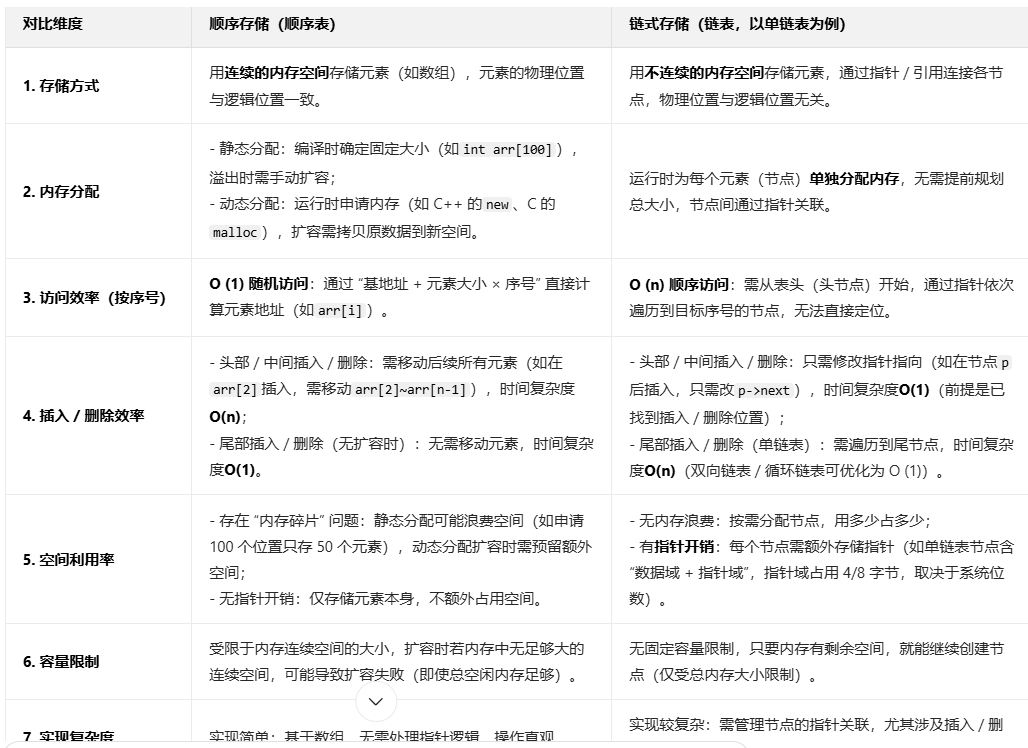
顺序
cpp
#include<iostream>
#define MaxSize 50
using namespace std;
typedef int elemType;
//初始化线性表
typedef struct
{
int length;
elemType date[MaxSize];
}SqList;
//建立顺序表
void CreateList(SqList*& L, elemType a[], int n)
{
int i = 0, k = 0;
L =(SqList *) malloc(sizeof(SqList));
while (i < n)
{
L->date[k] = a[i];
k++, i++;
}
L->length = k;
}
//初始化线性表
void InitList(SqList*& L)
{
L = (SqList*)malloc(sizeof(SqList));
L->length = 0;
}
//销毁线性表
void DestroyList(SqList*& L)
{
free(L);
}
//判断线性表是否为空
bool ListEmpty(SqList* L)
{
return (L->length == 0);
}
//求线性表的长度
int ListLength(SqList* L)
{
return (L->length);
}
//输出线性表
void DispList(SqList* L)
{
for (int i = 0; i < L->length; i++)
{
cout << L->date[i]<<" ";
}
}
//按序号求线性表中的元素
bool GetSqList(SqList* L, int i, elemType& e)
{
if (i<1 || i>L->length)
{
return false;
}
e = L->date[i - 1];
return true;
}
//按元素值查找
int LocateSqList(SqList* L, elemType e)
{
int i = 0;
for (i = 0; i < L->length; i++)
{
if (L->date[i] == e)
{
break;
}
}
if (i >= L->length)
return 0;
else
return i + 1;
}
//插入数据元素
bool ListInsert(SqList* L, int i, elemType e)
{
if (i<1 || i>L->length + 1 || L->length == MaxSize)
{
return false;
}
i--;
for (int j = L->length; j > i; j--)
{
L->date[j] = L->date[j - 1];
}
L->date[i] = e;
L->length++;
return true;
}
//删除数据元素
bool ListDelete(SqList* L, int i, elemType & e)
{
if (i<1 || i>L->length||L->length==0)
{
return false;
}
i--;
e = L->date[i];
for (int j = i; j <L->length-1; j++)
{
L->date[j] = L->date[j + 1];
}
L->length--;
return true;
}
int main()
{
SqList* L;
int date[10];
for (int i = 0; i < 10; i++)
{
date[i] = i + 1;
}
int n = sizeof(date)/sizeof(date[0]);
CreateList(L, date, n);
DispList(L);
elemType e;
GetSqList(L, 8, e);
LocateSqList(L, 8);
ListInsert(L,4, -1);
elemType s;
ListDelete(L, 10, s);
DispList(L);
DestroyList(L);
return 0;
}
//删除所有等于n的元素
void delnode(SqList*& L, int n)
{
int i = 0;
for (int k = 0; k < L->length; k++)
{
if (L->date[k] != n)
{
L->date[i] = L->date[k];
i++;
}
}
L->length = i;
}链式
cpp
#include<iostream>
using namespace std;
typedef int elemType;
typedef struct LNode
{
elemType date;
struct LNode* next;
}LinkNode;
//头插法
void CreateListF(LinkNode*& L, elemType a[], int n)
{
LinkNode* s;
L = (LinkNode*)malloc(sizeof(LinkNode));
L->next = NULL;
for (int i = 0; i < n; i++)
{
s= (LinkNode*)malloc(sizeof(LinkNode));
s->date = a[i];
s->next = L->next;
L->next = s;
}
}
//尾插法
void CreateListR(LinkNode*& L, elemType a[], int n)
{
LinkNode* s, * r;//s 负责承载新创建的元素节点,r 负责跟踪链表的尾部位置
L= (LinkNode*)malloc(sizeof(LinkNode));
r = L;
for (int i = 0; i < n; i++)
{
s= (LinkNode*)malloc(sizeof(LinkNode));
s->date = a[i];
r->next = s;
r = s;
}
r->next = NULL;
}
//初始化线性表
void InitList(LinkNode*& L)
{
L = (LinkNode*)malloc(sizeof(LinkNode));
L->next = NULL;
}
//销毁线性表
void DestroyList(LinkNode*& L)
{
LinkNode* pre = L, * p = L->next;
while (p != NULL)
{
free(pre);
pre = p;
p = p->next;
}
free(pre);
}
//判断线性表是否为空
bool ListEmpty(LinkNode* L)
{
return (L->next == NULL);
}
//求线性表的长度
int ListLength(LinkNode*& L)
{
int n=0;
LinkNode* p = L;
while (p->next!= NULL)
{
n++;
p = p->next;
}
return (n);
}
//输出线性表
void DispList(LinkNode*& L)
{
LinkNode* p = L->next;
while (p != NULL)
{
cout << p->date << " ";
p = p->next;
}
}
//按序号求线性表中的元素
bool Getelem(LinkNode* L, int i, elemType & e)
{
int j = 0;
LinkNode* p = L;
if (i <= 0)
{
return false;
}
while (j < i && p != NULL)
{
j++;
p = p->next;
}
if (p == NULL)
{
return false;
}
else
{
e = p->date;
return true;
}
}
//按元素值查找
int LocateList(LinkNode* L, elemType e)
{
int i = 1;
LinkNode* p = L->next;
while (p != NULL && p->date != e)
{
i++;
p = p->next;
}
if (p == NULL)
{
return 0;
}
else
{
return i;
}
}
//插入数据元素
bool ListInsert(LinkNode*& L, int i, elemType e)
{
int j = 0;
LinkNode* p = L,*s;
if (i <= 0)
{
return false;
}
while (j < i - 1 && p != NULL)
{
j++;
p = p->next;
}
if (p == NULL)
{
return false;
}
else
{
s=(LinkNode*)malloc(sizeof(LinkNode));
s->date = e;
s->next = p->next;
p->next = s;
return true;
}
}
//删除数据元素
bool ListDelete(LinkNode*& L, int i, elemType& e)
{
int j = 0;
LinkNode* p = L, * q;
if (i <= 0)
{
return false;
}
while (j < i - 1 && p != NULL)
{
j++;
p = p->next;
}
if (p == NULL)
{
return false;
}
else
{
q = p->next;
if (q == NULL)
{
return false;
}
e = q->date;
p->next = q->next;
free(q);
return true;
}
}